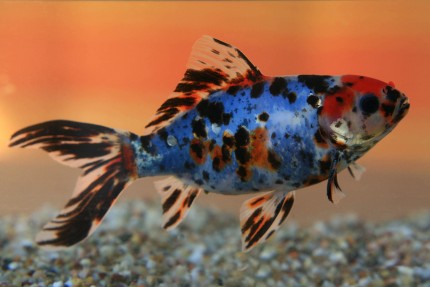Sturgeon Waxdick - Acipenser gueldenstaedtii
incl. VAT plus shipping costs
Immediate delivery, express possible ![]()
More than 20 Articles in stock
-10% EXTRA-RABATT
auf Deinen gesamten Warenkorb!!
- Item no: 29362
Fast delivery times
All products are in stock with us!14 years of breeding experience
Let our team of experts advise you!High customer satisfaction
from over 3,000 reviews "The Waxdick is a species of sturgeon from Russia. The bony fish Acipenser gueldenstaedtii looks like a creature from prehistoric times, but it is a lively and fascinating pond dweller. The Waxdick, Diamond Sturgeon or Russian Sturgeon is one of the largest representatives of the sturgeons, it grows up to 240 cm long and can weigh almost 110 kg. To feel comfortable, the Waxdick needs a very large pond or even better a lake.
Adult Waxdick live partly also in brackish water and sea water. Adult Waxdicks are found in the Black Sea, the Sea of Azov and the Caspian Sea. This sturgeon is also called Danube sturgeon or Ossietra sturgeon and is mainly used for caviar production in its native country. It has a high economic importance in Russia as a supplier of caviar.
The Russian Sturgeon has a characteristically elongated, spindle-shaped body with the typical 5 white longitudinal rows of bone shields and shiny melting scales on the black-gray, in places marbled ground color. The Waxdick has a lighter belly. The pointed snout is quite typical of sturgeons. It is covered with two pairs of barbels. In front of the eyes the Waxdick has two different nostrils each. The fins are relatively large and partly bordered by a white fringe, the anal fin is almost snow-white. The extended caudal fin is deeply split.
Sturgeons become sexually mature relatively late, males at 7-11 years and females at 11-15 years. The Waxdick is a spawning migrant, leaving the sea for the spawning season and migrating to freshwater rivers for mating. In the wild in Russia, Waxdick sturgeon are partly threatened with extinction, therefore our Waxdick come from responsible breeding. The Russian sturgeon migrates in habitat over many hundreds of kilometers to spawn. During the spawning season, Waxdicks band together in groups, while otherwise they tend to be solitary. The spawning cycle of the Waxdick is two to four years. Breeding in garden ponds is relatively unlikely due to the migratory nature of Russian Sturgeon.
The bottom-dwelling Russian Sturgeon is a predator and eats insect larvae, snails, and other smaller invertebrates such as crayfish, leeches, and other worms, but also eats the fry of other fish. Depending on their size, they will also eat adult fish that fit in the mouth of the Waxdick.
Sturgeons in the pond are fed with a special fast sinking sturgeon food. Floating foods for other pond fish should not be fed in a pond with Russian sturgeon because these pond fish will swallow too much air. Also, sturgeon eat very slowly and will come up short in a pond with other voracious eating fish such as koi. With a little patience, Waxdicks become tame enough to be hand fed.
Russian sturgeon are active and actually swim all day. Even in winter, sturgeons are out and about and do not hibernate. Therefore, they are not well suited for a pond with koi, for example, because they would greatly disturb the colorful carp during hibernation.
A pond for the Waxdick needs at least 30 cubic meters of water volume, a length of at least 20 meters and a water depth of 1.50 meters or even more. In summer, the Waxdick likes to seek out the deeper, cooler water layers because it does not like high water temperatures at all. Terraces of different heights in the pond ensure that you can also see the more bottom-oriented Waxdick. Sturgeons are solitary animals, so keeping a single Waxdick in the garden pond is not problematic.
Russian sturgeons need a strong current and have a high oxygen demand. A correspondingly large pond filter and an oxydator for garden ponds are mandatory. In the garden pond, the substrate on the terraces should be clay or mud, as diamondback sturgeon will forage in the substrate.
Sturgeons need a less dense pond planting and can even get caught in dense plant stands, which is a problem for the fish because they cannot swim backwards and may even die. Young Waxdick sturgeon can also become so entangled in filamentous algae that they can no longer get away, these algae must therefore always be kept low in the garden pond with young sturgeon.
| Scientific name | Acipenser gueldenstaedtii |
| German name: | Russian sturgeon, diamond sturgeon, waxdick |
| Difficulty level: | advanced |
| Origin/distribution: | Russia |
| Coloration: | dark or marbled ground color, light bone shields and melting scales, characteristic snout, light belly |
| Age expectancy | 20-50 years |
| Pond size: | 30,000 liters minimum |
| Food | Predators, insects, crayfish, small crustaceans, worms, leeches, fry, fish larvae, smaller fish |
| Breeding | rather difficult |
| Behavior | diurnal, very lively |
| Group size | Single keeping possible |
- Item no: 29362
- EAN No.: 4251932208811
Entdecke die Garnelio Welt!
Garnelio gehört zu den größten Onlineshops für wirbellose Aquarientiere weltweit.
Viele Artikel gibt es exklusiv nur bei uns im Shop.






























The fields marked with * are required.
I have taken note of the privacy policy.